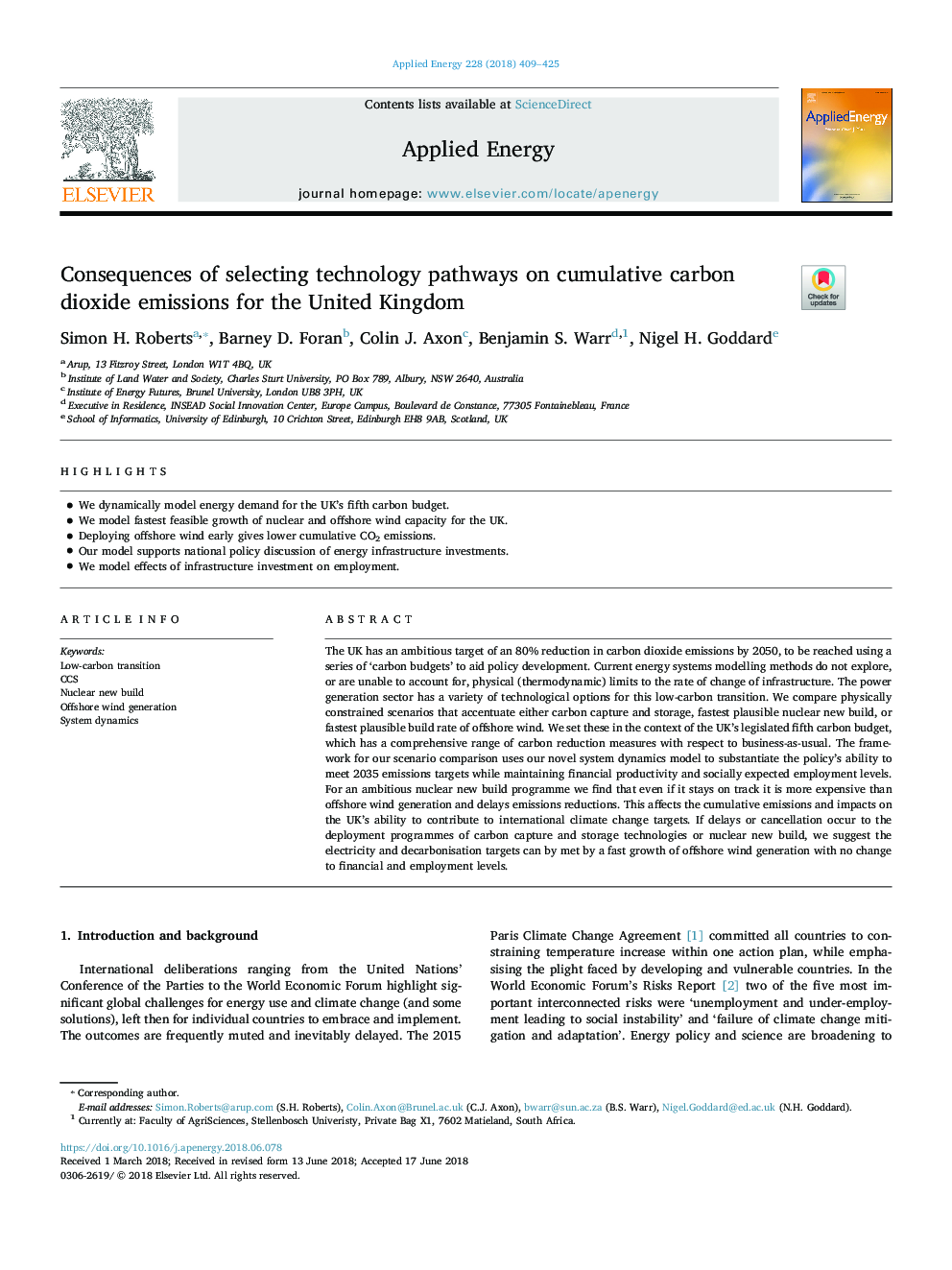| کد مقاله | کد نشریه | سال انتشار | مقاله انگلیسی | نسخه تمام متن |
|---|---|---|---|---|
| 6679716 | 1428063 | 2018 | 17 صفحه PDF | دانلود رایگان |
عنوان انگلیسی مقاله ISI
Consequences of selecting technology pathways on cumulative carbon dioxide emissions for the United Kingdom
ترجمه فارسی عنوان
پیامدهای انتخاب مسیرهای فناوری در انتشار کربن دی اکسید کربن در انگلیس
دانلود مقاله + سفارش ترجمه
دانلود مقاله ISI انگلیسی
رایگان برای ایرانیان
کلمات کلیدی
ترجمه چکیده
انگلستان هدف بلندپروازانه ای برای کاهش 80٪ انتشار دی اکسید کربن تا سال 2050 دارد که با استفاده از یک سری از "بودجه های کربن" برای کمک به توسعه سیاست ها به دست می آید. روش های مدل سازی سیستم های فعلی، محدودیت های فیزیکی (ترمودینامیکی) را به سرعت تغییر زیرساخت ها کشف نمی کنند یا قادر به آن نیستند. بخش تولید برق دارای گزینه های تکنولوژیکی متنوع برای این انتقال با کم کربن است. ما مقایسه سناریوهای محدود و فیزیکی را که موجب جذب و ذخایر کربن، سریعترین ساختار جدید هسته ی قابل قبول یا سریعترین میزان ساخت باد در دریای خزر می شود، را مقایسه می کنیم. ما این را در چهارچوب بودجه کربن پنجم قانون اساسی انگلیس قرار داده ایم که طیف وسیعی از اقدامات کاهش کربن را در رابطه با کسب و کار به طور معمول دارد. چارچوب برای مقایسه سناریو ما با استفاده از مدل پویایی سیستم رمان ما برای اثبات توانایی سیاست در دستیابی به اهداف اخراج 2035 در حالی که حفظ بهره وری مالی و سطح اشتغال اجتماعی انتظار می رود. برای یک برنامه بلندپروازانه جدید ساخت هسته ای، می بینیم که حتی اگر در مسیر حرکت قرار گیرد، گران تر از تولید انرژی باد در دریای خزر است و تاخیر در کاهش انتشار گازهای گلخانه ای است. این بر میزان انتشار تجمع یافته و تأثیرات بر توانایی انگلیس برای کمک به اهداف تغییر بین المللی تغییر آب تاثیر می گذارد. اگر تاخیر و یا لغو در برنامه های استقرار فن آوری های ضبط و ذخیره سازی کربن یا ساخت جدید هسته ای رخ می دهد، ما پیشنهاد می کنیم که هدف های برق و کاهش اتلاف انرژی با افزایش سریع تولید انرژی باد در دریای خزر بدون تغییر در سطوح مالی و اشتغال مواجه شود.
موضوعات مرتبط
مهندسی و علوم پایه
مهندسی انرژی
مهندسی انرژی و فناوری های برق
چکیده انگلیسی
The UK has an ambitious target of an 80% reduction in carbon dioxide emissions by 2050, to be reached using a series of 'carbon budgets' to aid policy development. Current energy systems modelling methods do not explore, or are unable to account for, physical (thermodynamic) limits to the rate of change of infrastructure. The power generation sector has a variety of technological options for this low-carbon transition. We compare physically constrained scenarios that accentuate either carbon capture and storage, fastest plausible nuclear new build, or fastest plausible build rate of offshore wind. We set these in the context of the UK's legislated fifth carbon budget, which has a comprehensive range of carbon reduction measures with respect to business-as-usual. The framework for our scenario comparison uses our novel system dynamics model to substantiate the policy's ability to meet 2035 emissions targets while maintaining financial productivity and socially expected employment levels. For an ambitious nuclear new build programme we find that even if it stays on track it is more expensive than offshore wind generation and delays emissions reductions. This affects the cumulative emissions and impacts on the UK's ability to contribute to international climate change targets. If delays or cancellation occur to the deployment programmes of carbon capture and storage technologies or nuclear new build, we suggest the electricity and decarbonisation targets can by met by a fast growth of offshore wind generation with no change to financial and employment levels.
ناشر
Database: Elsevier - ScienceDirect (ساینس دایرکت)
Journal: Applied Energy - Volume 228, 15 October 2018, Pages 409-425
Journal: Applied Energy - Volume 228, 15 October 2018, Pages 409-425
نویسندگان
Simon H. Roberts, Barney D. Foran, Colin J. Axon, Benjamin S. Warr, Nigel H. Goddard,
